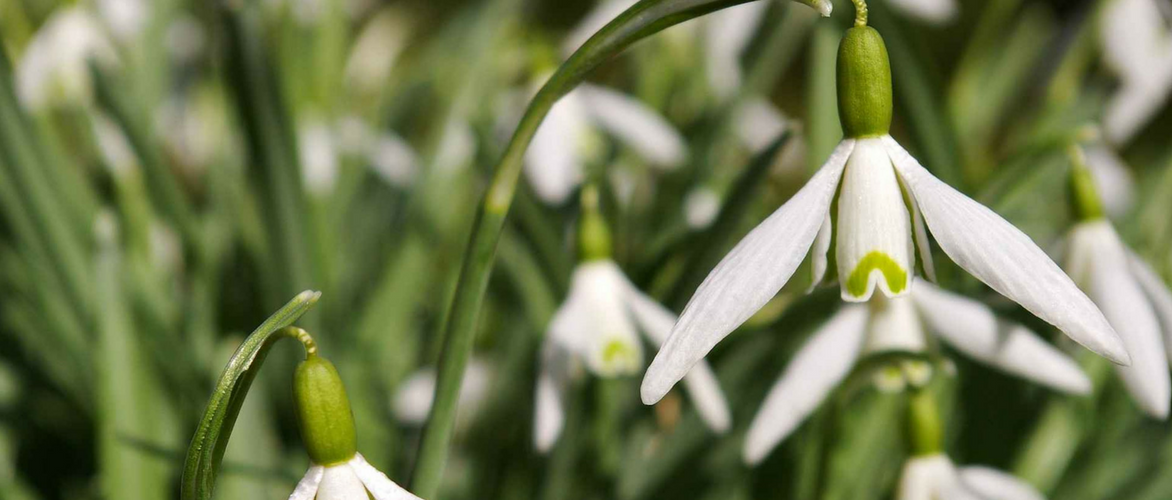
Snowdrop, Galanthus nivalis: planting, growing, caring
Contents
Snowdrop in a nutshell
- Snowdrop is one of the first bulbs to flower at the end of winter
- Low maintenance, hardy and prolific, it naturalises and multiplies very easily
- It is grown in large flowering tapetum, at the edge, in short grass meadow or at the foot of trees
- It creates beautiful white pots heralding spring
A word from our expert
Snowdrop or Galanthus nivalis is a bulbous flower among the first to announce the end of winter and the arrival of spring. Symbol of renewal, its small pure white bells often piercing through the last snow, emerge from January to March, from a naturalised ground cover, a short grass meadow, a light woodland, the foreground of a path border, a rock garden, or even a planter. While Snowdrop may evoke a well-known association for some, this beautiful, easy-to-grow bulb can be found in many naturalistic gardens.
Easy to care for and perfectly hardy, it grows almost everywhere in France, requiring no maintenance.
From Galanthus nivalis, the classic Snowdrop to the giant Galanthus elwesii, through Galanthus woronowii with its characteristic bright green foliage or Galanthus plicatus with its plicate leaves, this must-have for gardens without gardeners thrives in partial shade under bushes, roses, or deciduous trees, at the edge of woodlands.
In well-drained soil, it will easily naturalise, forming over time, very floriferous carpets or beautiful foregrounds for borders at the onset of spring.
This prolific bulb adds a touch of freshness to the garden when paired with other early bulbs like crocus, squills and Leucojum vernum with which it creates lively displays. It thrives alongside Anemones, Muscari, Hyacinths, Ipheions, Iris reticulata, Erythroniums, Daffodils, Jonquils, and early Tulips that will take over the flowering. Winter Hellebores, Snow Heaths, and Vinca Minor will be perfect perennials associated with these small bulbs in delicate scenes.
Because one can never plant enough of these small bulbs that slip in everywhere and brighten grey days with their graceful inflorescences, discover our collection of Snowdrops with single or double flowers like the astonishing cultivar ‘Flore Pleno’ to flower the garden from the end of winter or to create delicate planters.
Botany
Botanical data
- Latin name Galanthus
- Family Amaryllidaceae (Liliaceae)
- Common name Snowdrop, Snowdrop, Nivalis des neiges
- Flowering From January to March
- Height 20 cm
- Exposure Sun, Partial shade
- Soil type Clay-loamy
- Hardiness Below -15°
The Snowdrop, Galanthus or “Nivalis des neiges”, is a delicate little bulbous plant from the Amaryllidaceae family, native to Asia Minor and Central Europe, where it grows in rocky soils and wooded areas. It is sometimes confused with its cousin, the Leucojum, from which it is distinguished by the shape of its petals.
While the genus includes 19 species of bulbous perennial plants, not counting wild snowdrops, 3 are the most commonly marketed and cultivated in France: Galanthus nivalis, the type species, Galanthus elwesii, the giant snowdrop, which is about twice the size of other species, and Galanthus woronowii with its characteristic bright green foliage. There is also Galanthus plicatus, a variety that is much more easily found in England or Holland. Galanthus nivalis comes in many varieties and cultivars, some of which are very interesting, bearing double flowers like the snowdrop ‘Flore Pleno’.
Perfectly hardy, the snowdrop can withstand temperatures below -15°C. It can be grown almost anywhere in France, but it dislikes dry soils and long, hot summers typical of the Mediterranean climate. It thrives in contrasting climates and requires a period of cold to flower well.
Vigorous and very prolific, these little bulbous plants form numerous bulbils that spread year after year. They are easy to naturalise in the garden and also self-seed spontaneously: they multiply quickly in short grass meadows without requiring any maintenance, eventually forming lovely flowering colonies over time.
Once well established in well-drained soil, the snowdrop will flower for many years, provided the bulbs are divided every 3-4 years to ensure the plant’s longevity and maintain the vigour of the flowers. The snowdrop bulb is known to be toxic… but only in case of ingestion!
In winter, this herbaceous plant, which we had almost forgotten, emerges from the ground to form a vigorous tuft 15-25 cm tall. Each bulb produces one to two stems, each bearing a small pendulous flower 2 to 5 cm long, directed outward from the tuft.
Its flowers are among the beautiful surprises of the garden in winter. Its early flowering, heralding spring, awakens the garden still asleep from the cold.
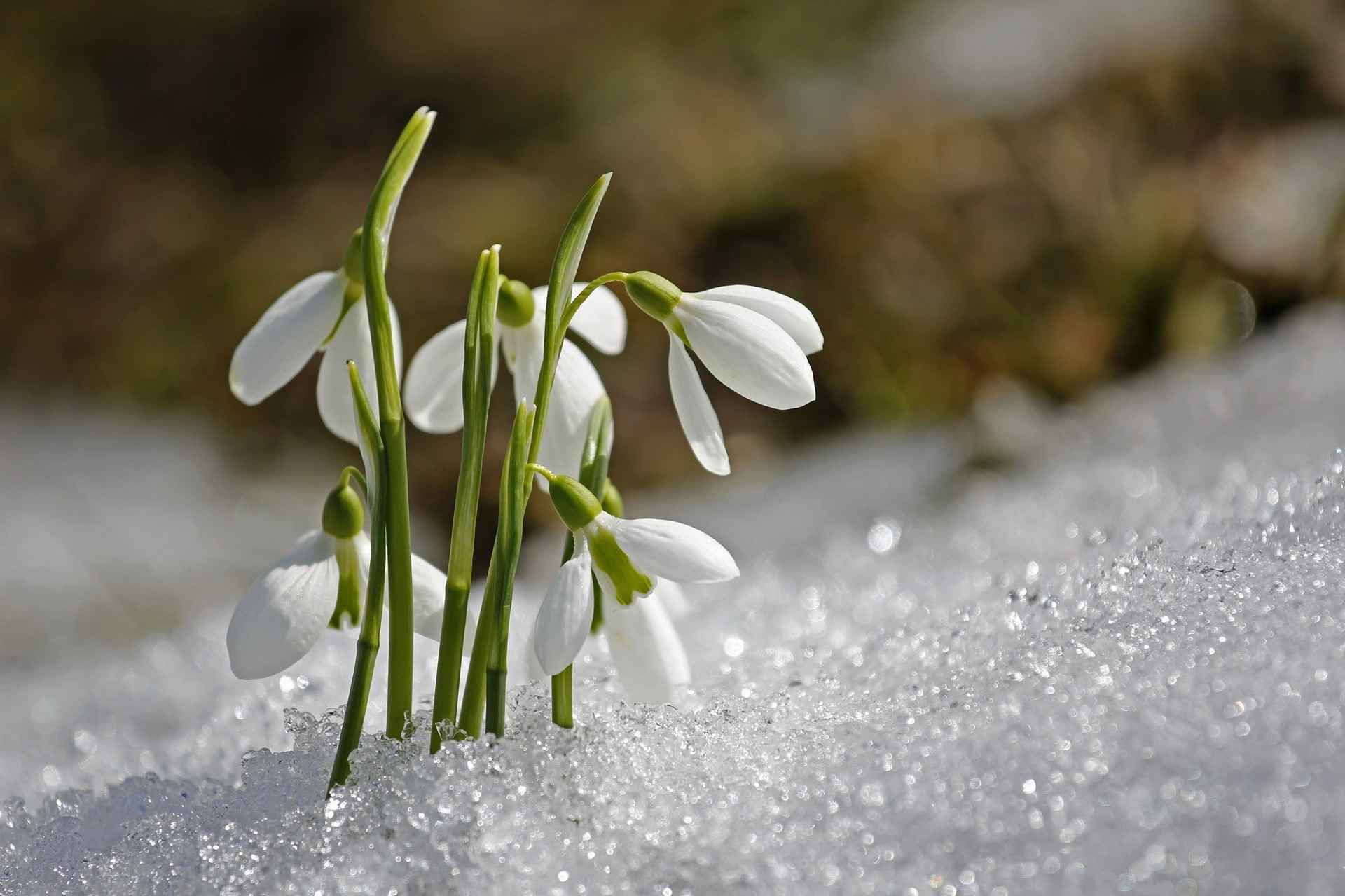
Delicate as snowflakes, the bells of Galanthus are the first to pierce the snowy mantle
Like the Crocus, and often before it, the Galanthus nivalis is one of the first flowers to bloom at the end of winter, sometimes as early as January, more often in February. With its elegant simplicity, its small winter bells resembling a drop of milk often pierce the last snow. In Greek, Galanthus nivalis literally means “milk flower”. Their flowering extends from January to March and lasts about 3 weeks.
Delicate and airy like snowflakes, the flowers of the snowdrop vary according to the varieties; they can be single or double. All are composed of an outer crown formed by 3 long, slightly bulging external tepals of immaculate white, sometimes marked with green at the tip, widely spread. They shelter an inner corolla that is hidden from view.
In simple forms, the tips of the white petals bear an inverted V-shaped green mark. In double-flowered varieties, which are more showy, they crown a rosette of central petals that are white variegated with emerald green or marked with yellow. The variety nivalis pleniflorus ‘Dionysus’ is an unusual form with its curiously shaped flowers. This little gem, considered a collector’s plant, consists of a small heart of frilled central petals, speckled with a dark green mark edged in white.
These delicate pendulous inflorescences, directed outward from the tuft and inclined towards the ground, disappear with the arrival of the first spring warmth. They are melliferous and exude a light honey fragrance.
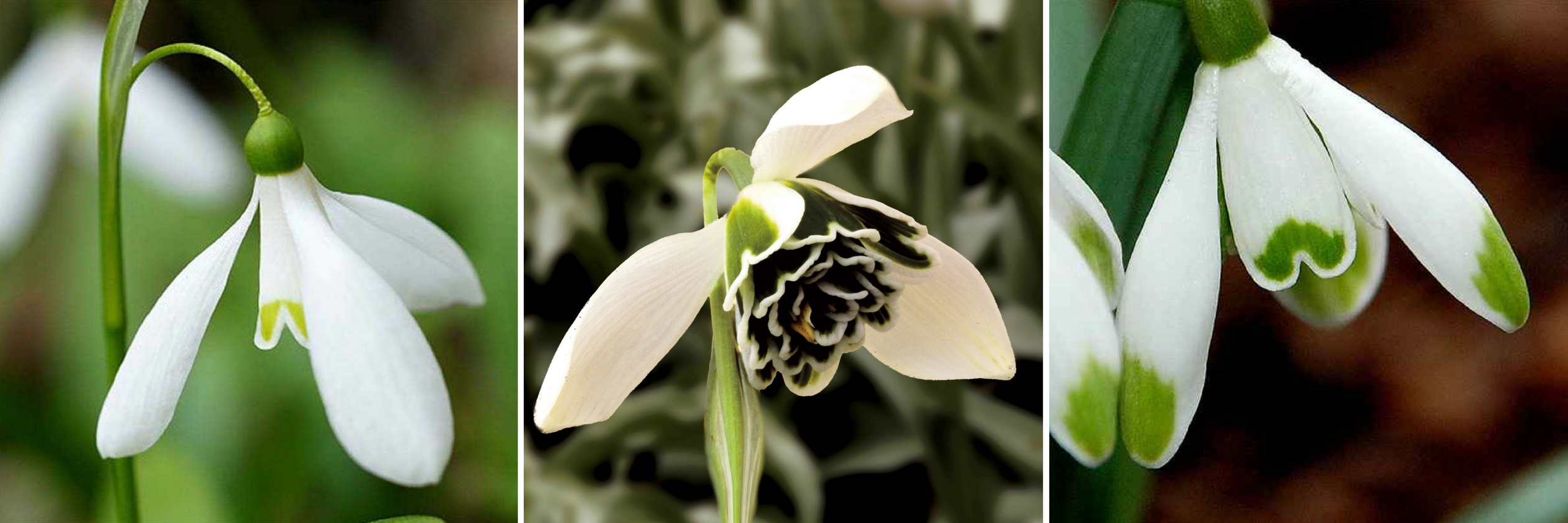
Galanthus Woronowii-G. nivalis pleniflorus ‘Dionysus’ -G.nivalis ‘Viridi’
The foliage appears early in the season. A tuft composed of ribbon-like leaves, more or less narrow and more or less upright, serves as a setting for this early flowering: the leaves, sheathed at the base of the flower stalk, are presented in pairs and incline more or less steeply towards the ground depending on the species.
The colour of the foliage varies according to the varieties, from glaucous green to very bright light green (Galanthus woronowii). With a waxy texture, sometimes slightly shiny, 5 to 20 cm long, they end in some Galanthus with a short cap-like tip. Some, like Galanthus plicatus, have broader leaves and, as its name suggests, shallow grooves that give them a characteristic plicate appearance. Others have a single marked central vein. The twisted strap-like foliage of Galanthus elwesii is more vigorous than that of the type species.
Deciduous, it yellows and then disappears at the end of spring, leaving a gap in the flower beds, only to return in winter.
Easy to grow and accommodating, the snowdrop multiplies rapidly in all cool soils in summer, soft, and especially well-drained in winter. It will struggle more in calcareous soil. It dislikes heavy soils that promote bulb rot, as well as overly dry soils in summer. It is planted in partial shade, especially in southern regions; in a cool climate, it will tolerate sunny exposures well. It is also a good plant for light woodland as it flowers well before the foliage of deciduous trees appears.
This little bulbous plant naturalises easily, sometimes becoming invasive, which can be an interesting asset in a naturalistic garden, to flower a light woodland or a difficult-to-access slope.
Planted in numbers with early crocuses in a lawn, this plant is ideal for large-scale naturalisation, also creating beautiful flowering carpets in winter. Used as ground cover, it can colonise slopes. Established at the foot of roses or deciduous trees with crocus tommasinianus, and other bulbous plants or plants that will take over like winter aconites, muscaris, hyacinths, daffodils, Anemone Blanda, winter hellebores, and scillas, the snowdrop contributes to fresh tableaux, heralding the end of winter and the approaching spring.
The small snowdrop bulbs slip everywhere between the plants, without suffocating the perennials already in place, like the Bleeding Hearts, winter heathers, Bergenia as the foliage disappears when the latter come into growth. It will also thrive, planted in dense small groups, at the front of a border close to the house to admire its flowering, as in a fresh rockery with Cyclamen Coum, pansies, creeping Bugle, Ipheion, and small ferns. Its charming flowering is also very suitable for cultivation in pots or planters mixed with pansies, crocuses, muscaris, or primroses.
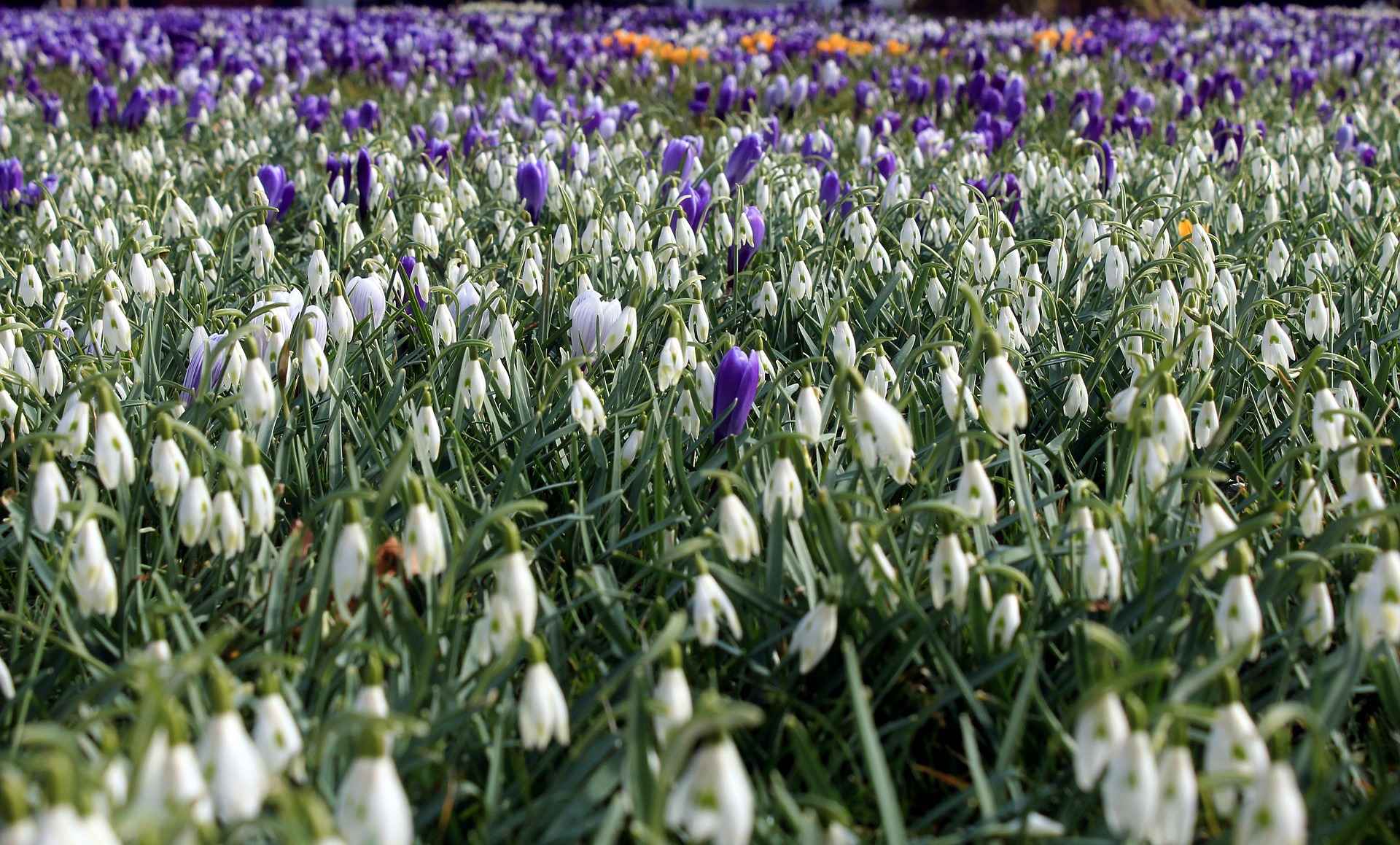
The snowdrop is an ideal plant for large-scale naturalisation, here it composes delicate flowering carpets with crocuses
Read also
How to propagate snowdrops?Species and varieties
The genus Galanthus includes 19 species of bulbous perennial plants, but in France, only a few species are most commonly sold in nurseries and cultivated in gardens:
- Galanthus nivalis, this is the type species with its glaucous foliage and small white flowers marked with green. It is the source of many varieties and cultivars that are easily found in commerce. The most interesting cultivar is undoubtedly the snowdrop ‘Flore Pleno’ with its double flowers. ‘Viridi-Apice’ is a variety that is slightly taller than the type species. ‘S. Arnott’ shows a more significant development than the others, reaching up to 25 cm in height and producing widely open single white flowers.
- Galanthus elwesii, this is the giant snowdrop that measures about twice the size of the other species.
- Galanthus woronowii which differs from the other species by a characteristic very light bright green foliage and not grey-green.
- Galanthus plicatus, a variety that is much more easily found in England or Holland, which has broad upright green leaves that are wider than those of Galanthus nivalis.
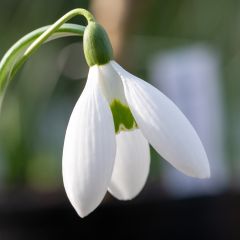
Galanthus elwesii
- Flowering time March, April
- Height at maturity 20 cm
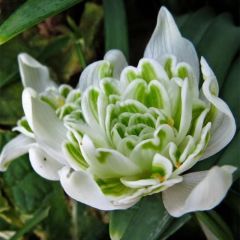
Galanthus nivalis f. pleniflorus Flore Pleno
- Flowering time March, April
- Height at maturity 15 cm
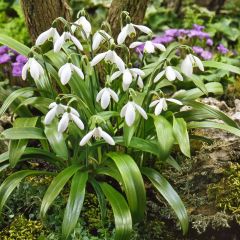
Galanthus woronowii
- Flowering time February to April
- Height at maturity 20 cm
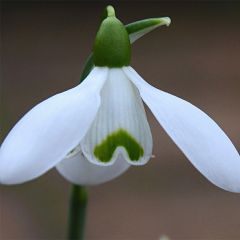
Galanthus nivalis Sam Arnott
- Flowering time April, May
- Height at maturity 25 cm
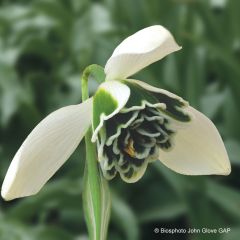
Galanthus nivalis f. pleniflorus Dionysus
- Flowering time March, April
- Height at maturity 20 cm

Galanthus nivalis Sam Arnott
- Flowering time April, May
- Height at maturity 25 cm
Discover other Galanthus - Snowdrop
View all →Available in 1 sizes
Available in 1 sizes
Available in 1 sizes
Available in 1 sizes
Available in 1 sizes
Available in 1 sizes
Available in 1 sizes
Available in 1 sizes
Available in 1 sizes
Available in 1 sizes
Young plantation
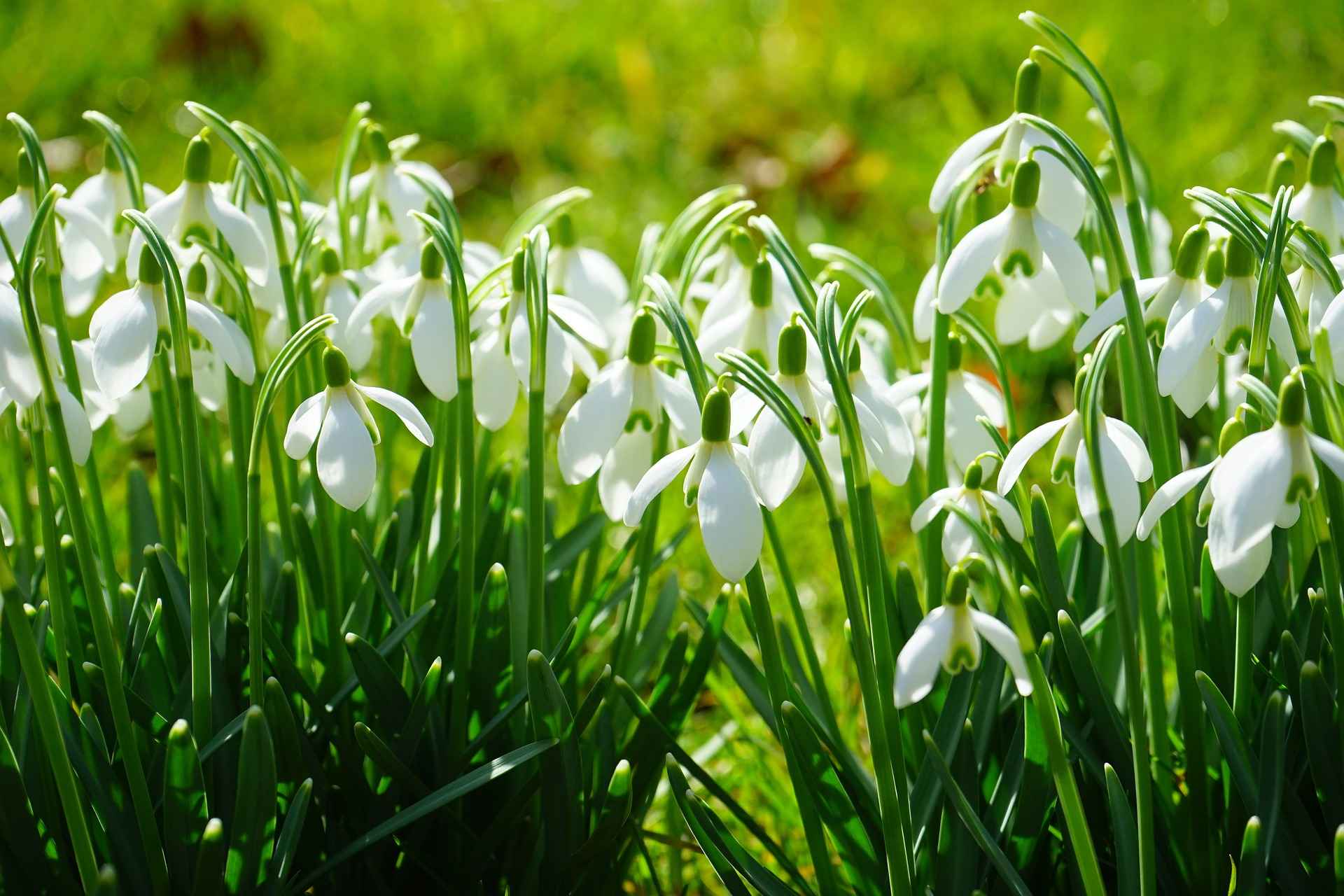
Plant Snowdrop bulbs directly in the lawn!
When to plant Snowdrops?
As soon as possible, Snowdrop bulbs should be planted early from September to mid-October.
Where to plant Galanthus nivalis?
Snowdrop can be grown almost anywhere in France. In the long dry summers of the southern regions, it prefers contrasting climates: its bulb needs a period of cold to flower well. With good hardiness, it is not afraid of snow and can withstand temperatures below -15°C.
Easy to grow, Snowdrop multiplies quickly as long as it is planted in cool, humus-bearing soil in summer, and especially well-drained in winter. It dislikes heavy, waterlogged soils that promote bulb rot, as well as soils dried out by intense summer heat. It can tolerate calcareous soil.
Once established, its clumps will remain in place for many years, sometimes becoming invasive.
This small bulb appreciates the coolness of partial shade, especially in Mediterranean climates; in cooler climates, it will tolerate sunny exposures well. Its propensity for naturalisation makes it an ideal plant to scatter in lawns during winter, creating flowering carpets as ground cover on slopes. It also thrives in light woodland at the foot of deciduous trees, along paths or borders, in cool rockeries, or in pots.
Versatile, it pairs well with certain perennials such as Bleeding Hearts, Heucheras, Snow Heaths, pansies, and other early small bulbs that, like it, require little maintenance and will help stagger flowering: Crocus, Muscari, Blanda Anemones, Hyacinths, Daffodils…
How to plant Snowdrop bulbs?
These small bulbs should be planted closely for maximum effect, in well-drained soil to prevent bulb rot.
-
In small groups for a natural planting
Using a bulb planter, plant at a maximum depth of 8 cm, in groups of 20 to 40, spacing the groups about 10 to 15 cm apart. Prefer an irregular planting for a natural decorative effect.
-
In a lawn
For planting in a lawn, cut out patches of turf, then using a bulb planter, plant at a maximum depth of 8 cm. Reposition the patches of turf after planting the bulbs.
-
In a flowering carpet for a spectacular effect!
Snowdrop can serve as ground cover in partial shade or to colonise slopes. For a harmonious effect, trace an irregular, oval shape with rounded edges.
For a successful mass planting, count about 100 bulbs per m². Dig out part of the chosen border area to a depth of 12 to 15 cm, then place the bulbs spacing them about 5 cm apart. Backfill “en masse”.
-
In pots
You can easily force Snowdrop bulbs in the cold from autumn, to enjoy their flowering and fragrance at Christmas in the home. Do not plant them alone; pair them with early bulbs like Muscari, Daffodils, or Hyacinths. Spread a layer of clay balls for perfect drainage and fill with a mix of garden soil, potting soil, and pumice.
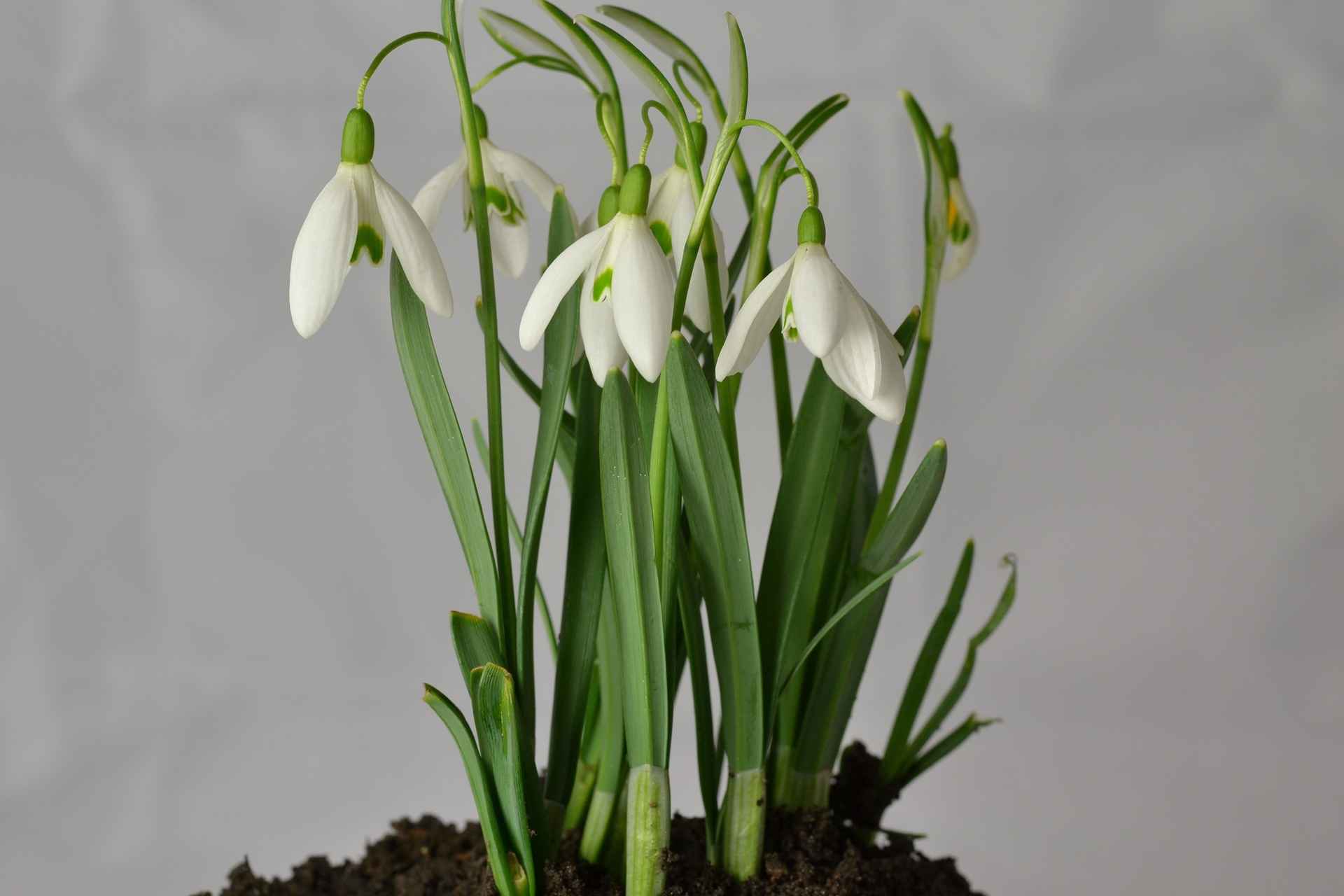
Maintenance and care
Low maintenance, the Snowdrop requires no special care. When the foliage turns yellow, after 3-4 years, it is time to dig up and divide the large clumps to maintain good vigour.
No pruning is necessary; however, if you want to control propagation by avoiding spontaneous sowing, cut the flower stems after flowering. To allow the bulb time to replenish its reserves for the following spring, leave the foliage in place, without cutting or mowing, until it has faded. Only potted plants require regular watering.
Learn more in our article How to care for snowdrops after flowering?
Diseases and potential pests
Snowdrop is a robust and disease-resistant plant that, when grown under good conditions, is not afraid of much and returns faithfully year after year. The narcissus fly is its main enemy: removal of affected bulbs is obligatory in the event of an attack. The other threat is grey rot caused by excess water. Well-drained soil will keep the bulbs healthy and prevent contamination by this fungus.
Multiplication
The germination of Snowdrop seeds is random, especially since this bulbous plant readily self-seeds. We recommend division, which is very simple to do and also helps to maintain vigorous clumps and abundant flowering.
After 3-4 years, divide the clumps. Preferably do this during full flowering in February when the foliage is still green or just after as the leaves begin to yellow.
5 secrets to successfully multiply Snowdrop
- Lift the clump with a fork, taking care not to damage the bulbs
- Cut the dried leaves
- Separate the bulblets one by one, by hand or with a small knife
- Replant the bulbs immediately at a depth of 5-8 cm in well-drained soil
- Firm the soil and water
Associate
Snowdrops are easy-to-associate flowering bulbs that pair well with a multitude of low-maintenance plants. Discreet yet reliable, they spread easily in naturalistic gardens or weekend gardens. Galanthus nivalis is ideal for colonising slopes, flowering borders, adorning a short grass meadow, creating floral carpets under deciduous trees or roses, ephemeral pots, awakening a rockery or a flowerbed of perennials still asleep from winter.
It is one of the first flowers to appear in spring, alongside spring Crocuses, Scillas, and Nivéoles, with which it forms early and vibrant floral carpets, heralding the arrival of spring. It thrives alongside other spring bulbs such as Anemones sylvestris and blanda, Muscaris, Hyacinths, Ipheions, Iris reticulata, Erythrones, Daffodils, Jonquils, and early Tulips that bloom early in the season and will take over the flowering.
In terms of perennials, Winter Hellebores, Snow Heaths, Creeping Bugles, Vinca Minor, primroses, and Ophiopogon with its decorative evergreen foliage, will look stunning when paired with these small bulbs in fresh and delicate scenes.
It is also a good plant for light woodland, preceding the flowering of Bleeding Hearts and Corydalis.
Snowdrop is wonderfully suited for pot cultivation behind a window in the house, on a terrace or balcony mixed with Crocuses, primroses, and Pansies, Cyclamen Coum, and small Daffodils that will extend the flowering season.
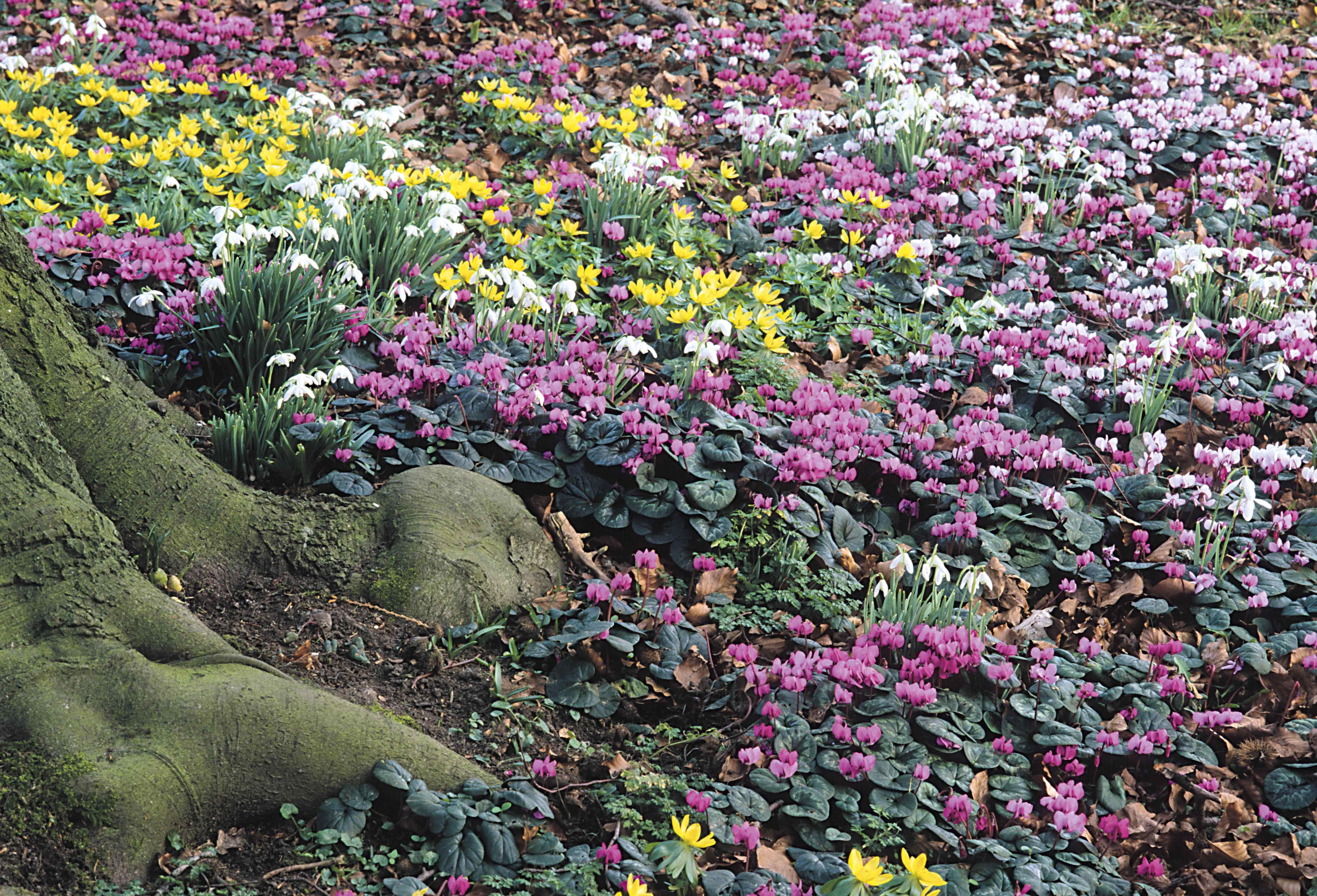
Cyclamen coum, Galanthus nivalis and Eranthis, a fresh and spring-like pairing
To go further
To discover:
- Our wide range of Snowdrops: it includes the best varieties, from the most classic to the rarest
- Advice sheet: Bulb size: understanding to make better choices
- Advice sheet: Snowdrops: 5 ideas for pairing them
- Tutorial: How to propagate Snowdrops?
- Advice sheet: 5 bulbs that flower in early winter
- Marion’s tips in Brighten up shady areas with spring bulbs!
- Subscribe!
- Contents































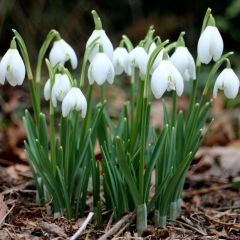

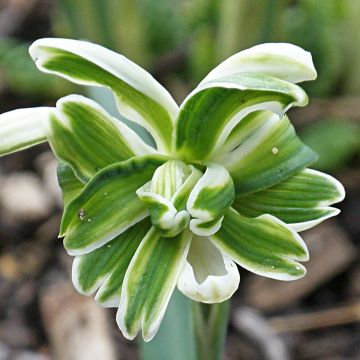

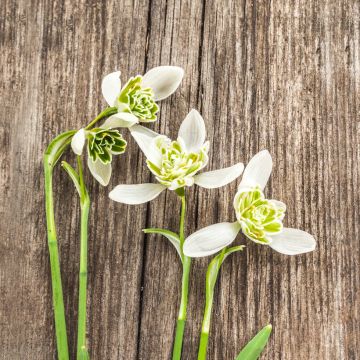
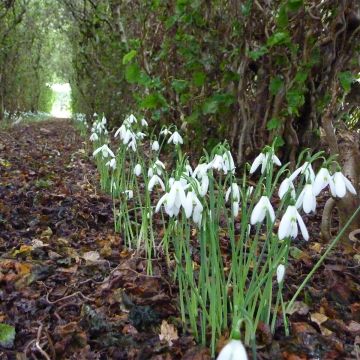

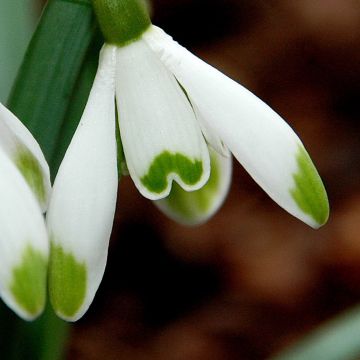

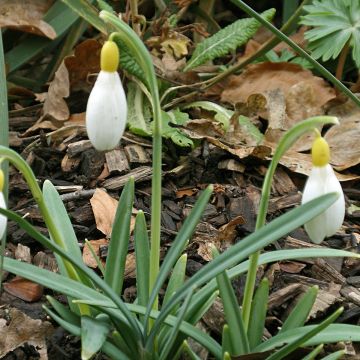

Comments